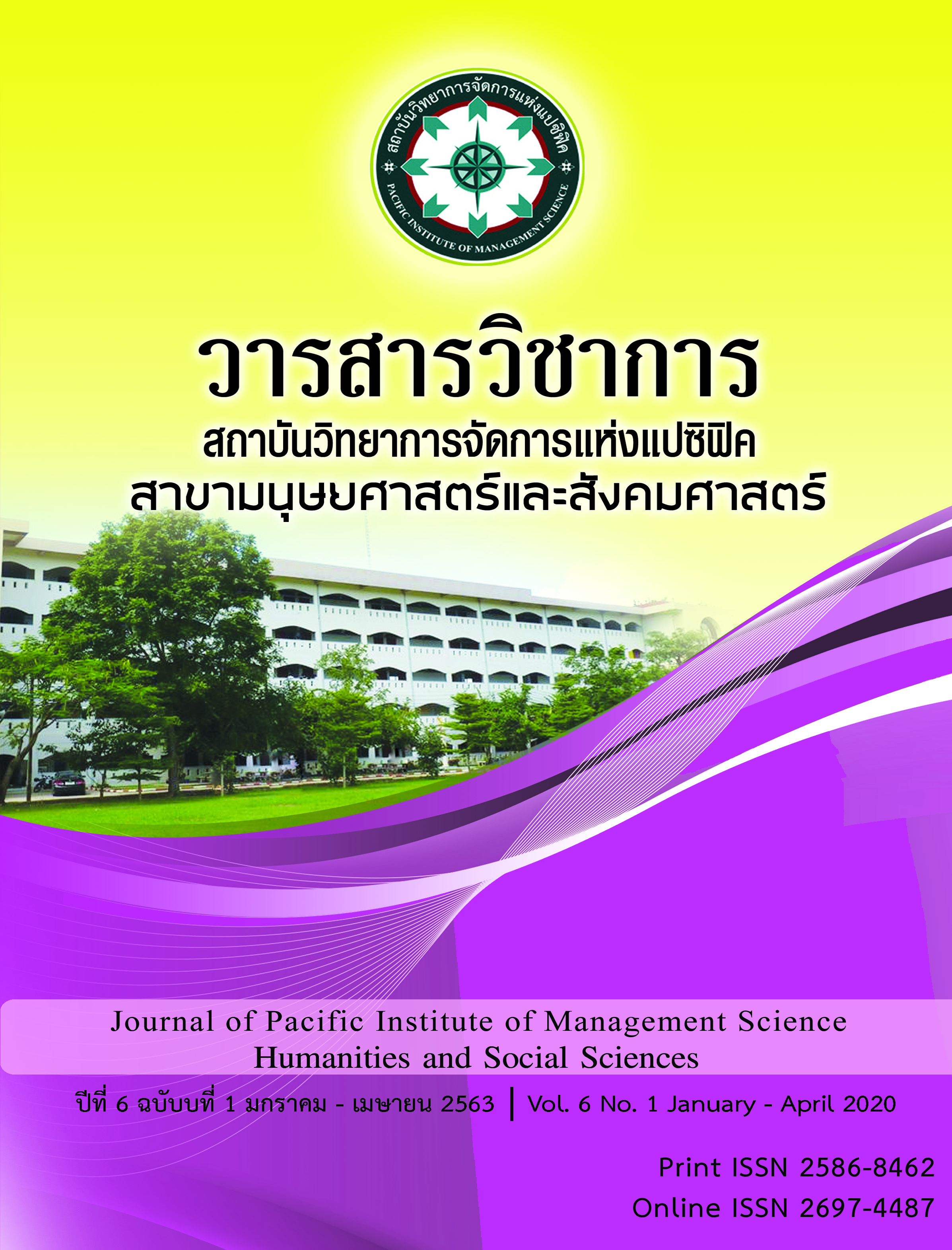A DEVELOPMENT OF CREATIVE LEADERSHIP FOR SCHOOL ADMINISTRATORS IN LOWER NORTH-EASTERN REGION
Keywords:
Creative Leadership, School Administrator, Lower North-Eastern RegionAbstract
The research “A development of creative leadership for school administrators in lower north-eastern region” was aimed to: 1) study creative leadership, 2) study the predictive factors of creative leadership, and 3) present the developmental approach in creative leadership for school administrators in lower north-eastern region. The mixed methodology of qualitative and quantitative was used with non-probability samplings which were the 8 school directors from lower north-eastern, 13 in focus group and in-depth interviewing qualitative research, and 576 in random for quantitative research. The findings resulted as: creative leadership was in in highest level, the leadership factors in depth knowledge and tactical performance can predict creative leadership for school administrators with a significance level of 0.05, and the developmental approach in creative leadership for school administrators focused on foundation of thinking and creative practicing concretely.
References
จันทนา แสนสุข. (2557). ปัจจัยที่เป็นเหตุและผลของความสามารถภาวะผู้นำ เชิงกลยุทธ์ ของสถาบันอุดมศึกษาในประเทศไทย. วารสารสมาคมนักวิจัย. (19)1: 34-46.
ธนวัฒน์, ภิรมย์ไกรภักดิ์. (2559). พฤติกรรมภาวะผู้นำทางวิชาการของผู้บริหารสถานศึกษา สังกัดสำนักงานเขตพื้นที่การศึกษาประถมศึกษา ในภาคตะวันออกเฉียงเหนือตอนล่าง. ครุศาสตรดุษฎีบัณฑิต สาขาวิชาการบริหารการศึกษา คณะครุศาสตร์ มหาวิทยาลัยราชภัฏบุรีรัมย์.
สนุก สิงห์มาตร, พิกุล มีมานะ และ ดุษฎีวัฒน์ แก้วอินทร. (2560). คุณลักษณะภาวะผู้นำของผู้บริหารองค์กรในศตวรรษที่ 21. คณะรัฐศาสตร์และรัฐประศาสนศาสตร์ มหาวิทยาลัยราชภัฏมหาสารคาม.สำนักงานเลขาธิการสภาการศึกษา กระทรวงศึกษาธิการ. (2553). ประสิทธิภาพและการบริหารจัดการของมหาวิทยาลัยในกำกับของรัฐ. กรุงเทพฯ: สำนักงานเลขาธิการสภาการศึกษา กระทรวงศึกษาธิการ.
อุดม มุ่งเกษม. (2545). Good Governance กับการพัฒนาข้าราชการ. กรุงเทพฯ : สถาบันพัฒนาข้าราชการพลเรือน สำนักงาน ก.พ.
Bass, Bernard M. & Avolio, Bruce J. (1994). Improving Organization Effectiveness through Transformation Leadership. Thousand Oaks: SAGE.
Bryman, A. (2001). Social Research Methods. Oxford: Oxford University
PressBhutanaro, T. (2017). Leadership and Community Development. Retire 4 April 2019 from www.goto know.org/posts Retrieved on June 11, 2560
Casse, P., & Claudel, P. G. (2007). Philosophy for creative leadership: How philosophy can turn people into more effective leaders.
n.p.Cui, et al. (2005) Drosophila Nod protein binds preferentially to the plus ends ofmicrotubules and promotes microtubule polymerization in vitro. Mol. Biol. Cell 16(11): 5400--5409.
Bryman, A; Collinson, D L; Grint, K; Jackson, B; Uhl-Bien, M. (2011). The Sage Handbook of Leadership. Los Angeles: Sage.
Danner, S. E. (2008). Creative leadership in art education: Perspectives of an art educator. Thesis Master of Arts, Art Education, Fine Arts, Ohio University.
Dubrin, A. J. (2010). Principles of leadership. South-Western: Cengage Learning.
Gardner. 1986. Probing more deeply into the theory of multiple intelligences. NASSP Bulletin.
Harris, A. (2009). Creative leadership. Journal of Management in Education, 23(1), 9-11.
Ken Kalala Ndalamba, Cam Caldwell & Verl Anderson. 2018. Ethical leadership introubled times. Retire4 April 2019 from Web site: www.researchgate.net/publication/317321114_Ethical_leadership_introubled_times.
Kouzes, J. & Posner. B. (1995). The Leadership Challenge: How to Keep Extraordinary Things Done in Organization. San Francisco CA: Jossey – Bass.
Krejcie, R. V. & Morgan, D. W. 1970. Determining Sample Size for Research Activities. Educational and Psychological Measurement. 30(3): 607-610.
Mayfield & Mayfield, M., & Mayfield, J. 2010. Developing a scale to measure the creative environment perceptions: A questionnaire for investigating garden variety creativity. Creativity Research Journal, 22(2): 162-169.
McCormick, M. J., Tanguma, J., & López-Forment, A. S. 2002. Extending self-efficacy theory to leadership: A review and empirical test. Journal of Leadership Education, 1(2): 34-49.
Mueller, J.S., Goncalo, J. A. & Kamdar, D. (2010). Recognizing creative leadership: Can creative idea expression negatively relate to perceptions of leadership potential? [Electronic version]. Cornell University, School of Industrial and Labor Relations.
Palus, C. J., & Horth, D. M. (2005). The leader’s edge: Six creative competencies for navigating complex challenges. San Francisco: Jossey Bass.
Philip Hallinger, Junjun Chen. (2015). Review of research on educational leadershipand management in Asia. inEducational Management Administration & eadership.43(1): 497.Reddin, William J. 1970. Managerial effectiveness. New York: McGraw-Hill.
Schank & Abelson. (2013). Scripts, Plans, Goals, and Understanding: An Inquiry into Human Knowledge Structures.in Language, 54(3): 952.
Schermerhorn, John R. (2005). Management. New York: John Wiley & Sons.
Sternberg, R. J. (2006). Creative leadership: it's a decision. Journal of Leadership,
(2), 22-24
Downloads
Published
Issue
Section
License
บทความที่ได้รับการตีพิมพ์เป็นลิขสิทธิ์ของ สถาบันวิทยาการจัดการแห่งแปซิฟิค
ข้อความที่ปรากฏในบทความแต่ละเรื่องในวารสารวิชาการเล่มนี้เป็นความคิดเห็นส่วนตัวของผู้เขียนแต่ละท่านไม่เกี่ยวข้องกับสถาบันวิทยาการจัดการแห่งแปซิฟิค และคณาจารย์ท่านอื่นๆในสถาบันฯ แต่อย่างใด ความรับผิดชอบองค์ประกอบทั้งหมดของบทความแต่ละเรื่องเป็นของผู้เขียนแต่ละท่าน หากมีความผิดพลาดใดๆ ผู้เขียนแต่ละท่านจะรับผิดชอบบทความของตนเองแต่ผู้เดียว







